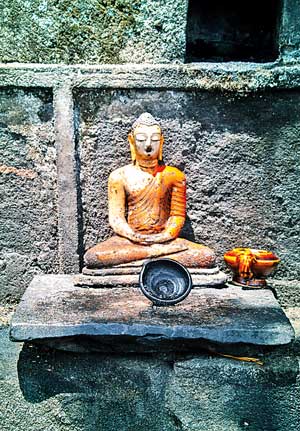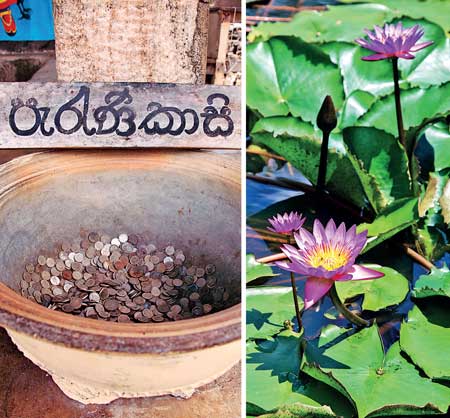Friday Apr 26, 2024
Friday Apr 26, 2024
Saturday, 25 March 2017 00:00 - - {{hitsCtrl.values.hits}}
By Aysha Maryam Cassim
Gadaladeniya Raja Maha Viharaya in Pilimathalawa never got my full attention until I stumbled upon a movie still of Purple Plain – a movie that was nominated in the category Best British Film of 1954 at the 8th British Academy Film Awards.
I was surprised to see Gregory Peck, the famous American actor against a Ceylonese background with an East Asian actress. Later I discovered that the particular scene was filmed in Gadaladeniya temple in Pilimatalawa.
Purple Plain’s story is based on H.E. Bate’s best-selling novel. The movie, which was a success at the box office, was mostly shot in Sri Lanka, including the Temple of Gadaladeniya to depict the Burmese locations. Gregory Peck plays a Canadian Pilot, Bill Forrester, serving in the Royal Air Force in Burma.

An ancient monastery
Gadaladeniya temple is an ancient monastery, perched on a rocky boulder at Diggala, in the proximity of Kandy. When you are travelling from Colombo to Kandy, you could turn right from Pilimatalawa Junction and proceed along Dawulagala Road to reach Gadaladeniya.
Gadaladeniya is among the largely undiscovered temples of Sri Lanka. It is a less-known tourist destination, frequented by local devotees, pilgrims, history enthusiasts and archaeologists. Usually, tourists and backpackers make a stopover in Pilimatalawa, en route to Kandy. Gadaladeniya, Lankathialaka and Embekke Devalaya make an ideal historical excursion that you can cover in less than half a day.
Gadaladeniya is a temple of many names. Historical evidence indicates that the temple was originally known as Dharma Kirthi Viharaya. “Nikaya Sangrahaya” identifies this temple as “Saddharmathilake” and “Saddharmalankaraya”.
Largest stone temple
Built on solid granite rock, Gadaladeniya temple is recognised as the largest stone temple in Sri Lanka that belong to one of the few existing architectural marvels of Gampola Kingdom.
The sacred ‘Bodiya’ that you find in front of the main Dagoba is secured by a fence. It is believed that this was nascent of Ananda Bodhiya which in near Devram Vehera at Dambadiva. The inscriptions near this tree reveal us that the temple has been built in the 14th Century by Senadhilankara with the guidance of Ven. Seelawamsa Dhammakeerthi, during the time where King Buvenakabahu IV was ruling the country. 
The chief architect of this temple was a South Indian named ‘Ganesvachari’. Unlike the temples, which were built during the Anuradhapura era, Gadaladeniya Raja Maha Viharaya reflects a strong Pandyan and Vijaynagar influence through its predominantly South Indian architectural features.
The Makara Thorana (dragon arch) in the main shrine room is embellished with Hindu gods and heavenly bodies like Brahma, Sathusta, Suyama and Natha. Next to the shrine room is a Devale dedicated to God Visnu.
Mahavansa – the great chronicle of Sri Lanka – proclaims that “Upulvan Deiyo” (a deity, identified with God Vishnu) was selected as the guardian to protect Buddhism within it at the time of Buddha’s passing away. Thus, it is believed God Vishnu has a special place among the Sri Lankans as the deity who awakened Buddhism in Sri Lanka.
At the entrance, to your right-hand side, you will find a Dagoba and four other small pagodas with four small shrine rooms surrounding it. This Stupa is believed to have built on bedrock by the King Parakramabahu V.
The main Dagoba is protected by a structure called Vijayothpaya or Vijayantha Prasada – named after the mythical palace of God Indra. It’s similar to a roof with four supporting pillars. The chamber within the Sikhara (dome) has housed a Buddha statue that was destroyed during the Portuguese occupation.
Under restoration
Today Gadaladeniya Temple looks dilapidated from perennial neglect. The temple was abandoned for a few centuries until the temple site was handed over to Velivita Sri Saranankara Sangaraja Thero by the king Viraparakrama Narendrasinha in (1707-1739 A.D.) Gadaladeniya Raja Maha Viharaya was maintained thereafter by his pupillary succession.
When I visited Gadaleniya in March 2017, the entrance to the temple palace was covered with scaffolding. I was told that the frescoes in the interior, which depict Jataka stories of Lord Buddha, seem to be fading.
Gadaladeniya Temple is under restoration now. But that doesn’t prevent us from enjoying the sheer beauty and serenity of the lush vegetation and rural scenery of Udunuwara from the top end of the monastery premises.